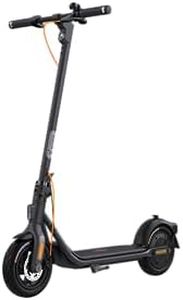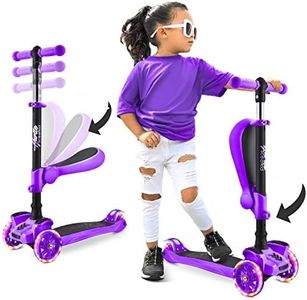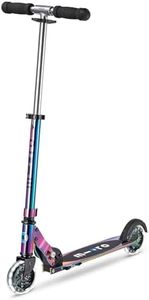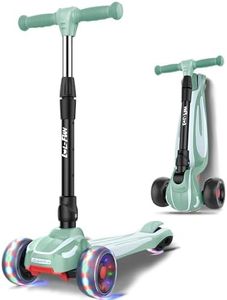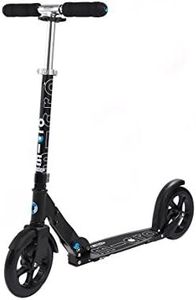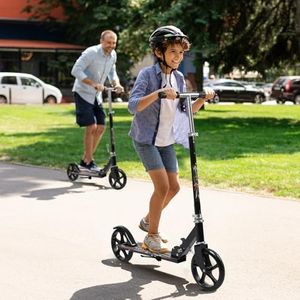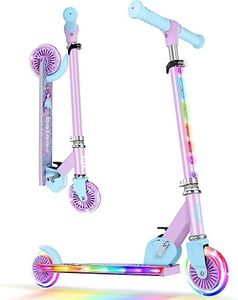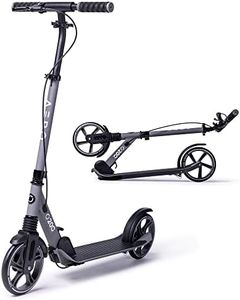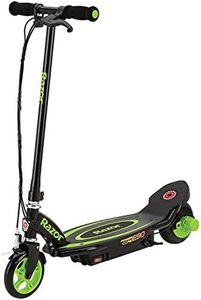We Use CookiesWe use cookies to enhance the security, performance,
functionality and for analytical and promotional activities. By continuing to browse this site you
are agreeing to our privacy policy
10 Best scooters
From leading brands and best sellers available on the web.By clicking on a link to a third party's website, log data is shared with that third party.
Buying Guide for the Best scooters
Buying a scooter can make your daily commute easier or add a dose of fun to your weekend adventures. When considering which scooter to buy, think about how and where you plan to use it: Do you need it for city commuting, weekend rides, or perhaps for short errands? Understanding your main purpose will help you make choices that fit your lifestyle, ensuring that your choice meets your needs for reliability, comfort, and convenience. Always pay attention to the manufacturer’s recommendations and safety features, and consider factors like local regulations and maintenance as part of your decision-making process.Engine Capacity (cc) / Motor Power (Watt)Engine capacity for petrol scooters is measured in cubic centimeters (cc), while electric scooters use motor power measured in watts. This indicates how powerful the scooter is and directly affects its speed and acceleration. Lightweight models (up to 50cc or below 350W) are generally more suitable for short city trips and younger riders. Mid-range options (50cc–125cc or 350–700W) balance speed and efficiency, making them good for medium commutes. Higher capacities (over 125cc or above 700W) are best if you need more speed or will be riding on hilly terrain. Consider how much performance you need: city riders usually don’t require very high power, while longer or mixed-terrain rides benefit from stronger engines or motors.
RangeRange refers to how far a scooter can travel on a full tank of fuel or a single battery charge. This is important because it determines how often you’ll need to refuel or recharge during your trips. Scooters with shorter ranges (up to 30 km/18 miles) are fine for short commutes or quick errands. Medium range (30–60 km/18–37 miles) is better for regular city commuting. Longer range (over 60 km/37 miles) suits people who have further to go or want to avoid frequent charging or refueling. Choose a range that easily covers your typical routes with a little extra for unexpected detours.
Weight and PortabilityWeight determines how easy a scooter is to maneuver, carry, or store. Lightweight scooters are easier to lift up stairs or put into a car trunk and are preferable if you’ll combine riding with public transit or storage is an issue. Heavier scooters offer more stability and comfort for longer rides but can be more difficult to move when not riding. Think about your own physical strength and storage needs—if you need to carry it often, prioritize lighter models; otherwise, focus on stability for daily rides.
Wheel SizeWheel size affects the scooter’s smoothness and stability. Smaller wheels (under 8 inches) make for a lighter and more portable scooter but can feel bumpier on rough roads. Medium wheels (8–10 inches) are better for a balance of comfort and portability, suitable for most city surfaces. Larger wheels (over 10 inches) provide better ride comfort and handle cracks or uneven roads well, which is ideal for longer or more varied terrains. Choose your wheel size based on the typical road conditions you expect to encounter.
Braking SystemBrakes are a critical safety feature, affecting how quickly and reliably you can stop. Mechanical brakes (like foot or drum brakes) are common in basic models and suitable for low speeds. Disc and electronic brakes deliver more stopping power and are preferable for higher speeds or frequent city starts and stops. If you expect to ride in wet conditions or hilly areas, opt for a scooter with reliable and responsive brakes.
SuspensionSuspension determines how well the scooter absorbs bumps in the road. Scooters without suspension are lighter and more affordable but may be uncomfortable on rough terrain. Basic suspension systems make city rides smoother, while advanced or dual suspension is better for uneven surfaces or daily longer rides. Assess how smooth your local roads are: the rougher they are, the more you will benefit from a good suspension system.
Build Quality & MaterialsThe materials used and overall build quality impact durability and comfort. Aluminum and steel frames tend to be strong and long-lasting, while plastic parts may reduce weight but can be less durable over time. Check for reliable construction if you plan to use the scooter daily or in all weather. For light, occasional use, a less robust build can still be sufficient.
Additional FeaturesModern scooters may come with extras like digital displays, built-in lights, storage compartments, or even smartphone connectivity. These features can make daily use safer, more convenient, and more enjoyable. Prioritize the features that will help with your specific needs, such as bright lights for night riding, or a display that shows battery status if you tend to take longer trips.

